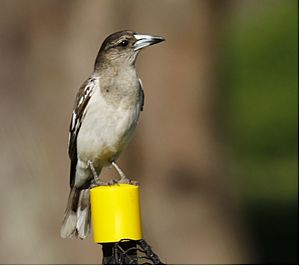Pied butcherbird facts for kids
Quick facts for kids Pied butcherbird |
|
|---|---|
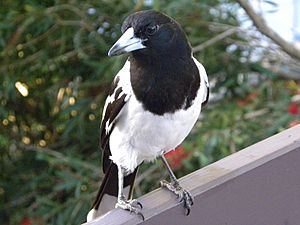 |
|
| Conservation status | |
| Scientific classification | |
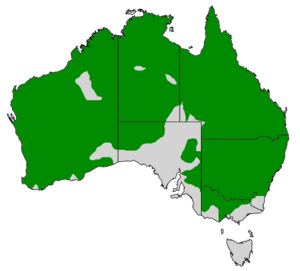 |
|
| Natural range |
The pied butcherbird (Cracticus nigrogularis) is a special songbird from Australia. It was first described by John Gould in 1837. This bird is mostly black and white. It is about 28 to 32 centimeters (11 to 13 inches) long. It has a long bill with a hook at the end.
Its head and throat are black, looking like a hood. Most of its back, tail, and wings are also black. The neck, belly, and outer wing feathers are white. Young butcherbirds are brown and white. As they grow, their brown feathers turn black. There are two types of pied butcherbirds.
Pied butcherbirds usually stay in one place. They live in woodlands and even in cities. These birds eat meat, like insects and small animals. They are friendly and curious birds. Sometimes, they even take food from people. They build cup-shaped nests in trees. They lay two to five eggs. Pied butcherbirds often help each other raise their young. A pair might have other birds help them. These groups protect their nesting area. The IUCN says the pied butcherbird is "least concern." This means it is not in danger because there are many of them.
Contents
About the Pied Butcherbird
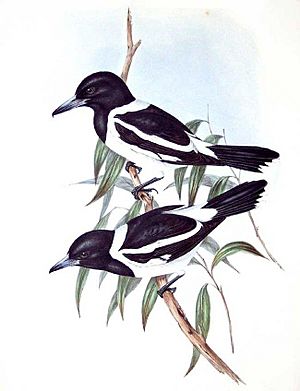
The pied butcherbird was first named by John Gould in 1837. He called it Vanga nigrogularis. The name nigrogularis comes from Latin words. Niger means black, and gula means throat. So, it means "black-throated." Gould found the first bird near Sydney.
Later, another type was found in northern Australia. It was called Cracticus picatus. This name means "black patches." It was later seen as a different type of pied butcherbird. Today, we know there are two main types, or subspecies. One lives in eastern Australia. The other lives in the Northern Territory, Western Australia, and northern South Australia. The northern type has a wider white collar.
Pied butcherbirds are part of a group called Cracticus. This group includes six or seven kinds of butcherbirds. They are related to the Australian magpie and currawongs. These birds are all part of the same family, Artamidae.
The official name for this bird is "pied butcherbird." Some other names for it are "black-throated butcherbird" or "organbird." This is because of its beautiful song. Indigenous people in Australia also have names for it. For example, the Ngarluma people call it gurrbaru.
What the Pied Butcherbird Looks Like
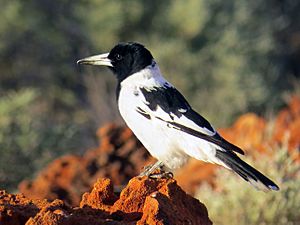
Like other butcherbirds, the pied butcherbird is a strong bird. It has short legs and a large head. It is about 28 to 32 centimeters (11 to 13 inches) long. Its wingspan is about 51 centimeters (20 inches). It weighs around 120 grams (4.2 ounces). Its feathers are mostly black and white. Males and females look very similar.
It has a black head, neck, and throat. This looks like a black hood. Around its neck is a white collar, about 3.2 centimeters (1.3 inches) wide. The black hood can look shiny in bright light. The female's collar is a bit narrower and grey-white. Some stiff black feathers grow near its beak. The upper part of its back is white. The lower back and tail are black. The rump is light grey. The tail is long and black with white tips. Its belly is white.
Its eyes are dark brown. Its legs are grey. The beak is pale blue-grey with a black tip. The end of the beak has a strong hook.
Young pied butcherbirds are dark brown instead of black. They do not have the white collar. Their throat and chest are cream or light brown. Their belly is off-white. The beak is dark brown. As they get older, they grow more dark brown feathers. Their beak becomes blue-grey with a dark tip.
The Pied Butcherbird's Voice
Many people think the pied butcherbird is Australia's best singer. Its song has been called a "magic flute." It is richer and clearer than the Australian magpie's song. The songs change from one part of Australia to another. There is no single song that all birds sing.
Pied butcherbirds often sing together. They can sing in pairs or even in larger groups. They are very good at making up new and complex songs. One of their calls sounds like the start of Beethoven's Fifth Symphony. They often sing at dawn, when the sun comes up. They rarely sing late in the day. Sometimes, they even sing on moonlit nights.
There are three main types of songs:
- Day song: This is the most common song. Birds sing it alone or in pairs. They sing it during the day, even while flying. It helps them bond and talk to each other.
- Whisper song: This song is sung more often when it's wet or windy. The bird sits in a tree and sings soft, complex tunes. It can sing for up to 45 minutes. It often copies other bird calls. It can even copy dogs barking or people whistling!
- Breeding song: During the breeding season, birds sing this song at night until dawn. It is longer and more complex than the day song.
If they feel in danger, pied butcherbirds make chattering sounds. They also make a loud alarm call. This call has short, loud notes that go down in pitch.
Similar Birds
The black hood helps you tell the pied butcherbird apart. Other butcherbirds, the Australian magpie, and the smaller magpie-lark look different. The magpie-lark also has a much smaller beak. The pied butcherbird's call is higher pitched than the grey butcherbird's. It also lives in more open areas. Young pied butcherbirds look a bit like grey butcherbirds. They have a light brown throat and dark brown feathers instead of black.
Where They Live and Their Home
The pied butcherbird lives in most parts of Australia. You won't find it in the far south or in Tasmania. It is rare around Sydney. In Victoria, it lives along the Murray River. In South Australia, it is not found in the northeast. It lives across Western Australia, but not in the Great Sandy Desert. These birds usually stay in the same area all year. They don't move much with the seasons.
They like open sclerophyll forests. They also live in woodlands with eucalypt and acacia trees. These areas have few or no bushes underneath. Sometimes, they live in areas with low shrubs like Triodia or Lomandra. They are not as common in mallee scrub. In dry areas, they stick to woodlands near rivers and billabongs. They have become more common in southwest Western Australia. This is because people cleared land there. But they are rare around Darwin due to city growth.
Conservation Status
The IUCN says the pied butcherbird is a "species of least concern." This means it is not in danger. It has a large range and its numbers seem stable. There is no sign of a big drop in its population.
Pied Butcherbird Behavior
Pied butcherbirds likely mate for life. However, their breeding habits are not fully known. We do know they often help each other raise young. A pair might have several other birds helping them. These helper birds feed the young. They also help protect the nest. These groups defend their territory from other birds. They will chase away birds of prey. Sometimes, they even chase dogs or people who get too close. They might attack if you get near their nest. One bird might come from the front, while another comes from behind.
The oldest pied butcherbird found lived a long time. It was banded in 1988 and found again in 2010. It was over 22 years old!
Reproduction
Pied butcherbirds usually breed from winter to summer. They lay eggs from July to December. Most eggs are laid from September to November. Young birds can be in the nest from August to February. Sometimes, they breed outside these months.
The nest is made of dry sticks. Inside, it has softer material like dried grass or bark. It is shaped like a cup. Nests are built in the fork of a tree. They are often hidden by leaves. A group of eggs is called a clutch. They usually lay two to five eggs. Most often, they lay three or four eggs. The eggs are oval-shaped. They are spotted with brown over a pale greyish- or brownish-green color.
Feeding Habits
The pied butcherbird eats meat. It eats insects like beetles, ants, and caterpillars. It also eats spiders and worms. It hunts small animals too. These include frogs, lizards, mice, and small birds. It has been seen eating silvereyes, house sparrows, and even ducklings. Farmers like pied butcherbirds because they eat pests like grasshoppers and rodents.
Some butcherbirds look for food near houses or picnic spots. They can become very friendly. They might even take food from people's hands. Pied butcherbirds also eat fruit. They eat fruits from sandpaper figs and native cherry trees. They also eat grapes. They drink nectar from flowers like the Darwin woollybutt.
The pied butcherbird often sits on a fencepost or branch. From there, it looks for food. It usually pounces on prey on the ground. Then it eats them there. Sometimes, it hops or runs along the ground to hunt. It might also catch flying insects. It usually hunts alone. Sometimes, two birds hunt together. They have even been seen hunting with an Australian hobby. The hobby might scare small birds out of bushes. Then the butcherbird catches them. Pied butcherbirds sometimes store food. They might stick it on a thorn or barbed wire. Or they might hide it in a small crack.
Cultural Importance
Many artists have been inspired by the pied butcherbird's song. Composers from Australia and other countries have used its songs in their music. These include Henry Tate, David Lumsdaine, and Olivier Messiaen. David Lumsdaine called the bird "a master of making and changing music."
In a dance called 'Bird Song' by Siobhan Davies, the main solo was set to the sound of a pied butcherbird. This sound also inspired much of the dance. A researcher named Hollis Taylor has studied their songs for 12 years. She even released a double CD of their night songs. Her book, 'Is Birdsong Music?', explores these amazing bird songs.
In the old Warray language, the pied butcherbird was called lopolopo. This language was spoken near the Adelaide River.
Images for kids
-
Bomen Lagoon, North Wagga Wagga, New South Wales
See also
 In Spanish: Verdugo gorjinegro para niños
In Spanish: Verdugo gorjinegro para niños



